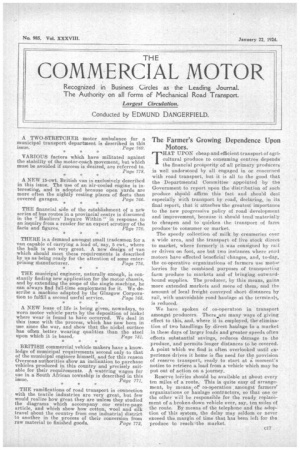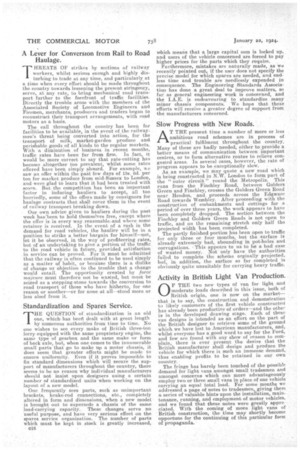The Farmer's Growing Dependence Upon Motors.
Page 1

Page 2

If you've noticed an error in this article please click here to report it so we can fix it.
HAT UPON cheap and efficient transport of agricultural produce to consuming centres depends the financial prosperity of all primary producers is well understood by all engaged in or concerned with road transport, but it is all to the good that the Departmental Committeeappointed by the Government to report upon the distribution of such produce slipuld affirm this fact and should deal especially with transport by road, declaring, in its final report, that it attaches the greatest importance to the new progressive policy of road development and improvement, because it should tend materially to cheapen and to quicken the transport of farm produce. to consumer or market.
The speedy collection of milk by creameries over a wide area, and the transport of live stock direct -to market, where formerly it was consigned by rail or driven on foot, are but two instances where road motors have effected beneficial changes, and, to-day, the co-operative organizations of farmers use motor lorries for the combined purposes of transporting farm produce to markets and of bringing outward bound supplies. The producer, by this means, gains more extended markets and more of them, and the amount of local freight conveyed short distances by rail, with unavoidable road haulage at the terminals, is reduced.
We have spoken of co-operation in transport amongst producers. There.are many ways of giving effect to this, and, where it is employed, the elimina tion of two handlings by direct haulage to a market in these days of larger loads and greater speeds often effects substantial savings, reduces damage to the produce, and permits longer distances to be covered. A point which we find is often overlooked until ex perience drives it home is the need for the provision of reserve transport, ready to start at a moment's notice to retrieve a load from a vehicle which may be put out of action on a journey.
Reserve lorries should be available at about every ten miles of a route.. This is quite easy of arrangement, by means, of co-operation .amongst farmers' organizations or haulage contractors, so that one or the other will be responsible for the ready replacement of a broken-down vehicle over, say, ten miles of the route. By means of the telephone and the adoption of -this system, the delay may seldom or never exceed the, margin of time that has been left for the produce to reachAhe market.
A Lever for Conversion from Rail to Road Haulage.
THREATS OF strikes by sections of railway workers, whilst serious enough and highly disturbing to trade at any time, and particularly at a time when every effort should be made throughout the country towards lessening the present stringency, serve, at any rate, to bring mechanical road transport further to the forefront of traffic facilities. Directly the trouble arose with the members of the Associated Society of Locomotive Engineers and Firemen, merchants, producers and traders began to reconstruct their transport arrangements, with road motors as a basis.
The call throughout the country has been for facilities to be available, in the event of the railwaymen's threat being converted into action, for the • transport of milk, market-garden produce and perishable goods of all kinds to the regular markets. With a diminution of business in recent months, traffic rates have been far from firm. In fact, it would be more correct to say that rate-cutting has become altogether too prevalent., whilst some rates offered have been simply absurd. For example, IA. e saw an offer within the pat few days of 13s. 6d. per ton for market produce from mid-Sussex to London, and-were glad to learn that it had been treated with scorn. But the competition has been an important factor in inducing hauliers to accept, all too hurriedly, some of the offers made by consignors for haulage contracts that shall cover them in the event of railway transport breaking down. Our own advice given to hauliers during the past week has 'been to hold themselves free, except where the offer is in every way reasonable.and where some retainer is received. In the event of a rush in the demand for road vehicles, the haulier will be in a position to strike a better bargain for himself—not, let it be observed, in the way of profiteering rates, but of an undertaking to give a portion of the traffic to the road vehicle in future, provided satisfaction in service can be proved. For it must be admitted that the railway is often continued to be used simply as a matter of habit, or because there is a dislike of change or objection to the trouble that a change would entail. The opportunity created by force majeure must therefore not be wasted, but must be seized as a stepping-stone towards the conversion to road transport of those who have hitherto, for one reason or another—or for none at all—stood more or less aloof from it.
Standardization and Spares Service.
THE QUESTION of standardization is an old one, which, has been dealt with at great length by numerous authorities from time to time. No one wishes to see every make of British three-ton lorry-equipped with the same proprietary engine, the same type of gearbox and the same make or form of back axle, but, when one comes to the innumerable small parts that go to make up a motor chassis, it does seem that greater efforts might be made to ensure uniformity. Even if it proves impossible to fix standard dimensions which will secure the support of manufacturers throughout the country, there seems to be no reason why individual manufacturers should not insist upon designers using a certain number of standardized units when working on the
layout of a new model. .
One frequently sees parts such as unimportant brackets, brake-rod connections, etc., completely altered in form and dimensions, when a new model is brought out to supersede a chassis of the same load-carrying capacity. These changes serve no useful purpose, and have very serious effect on the spares service organization. The number of parts which must be kept in stock is greatly increased,
018
which means that a large capital sum is locked up, and users of the vehicle concerned are forced to pay higher prices for the parts which they require. Furthermore, mistakes are naturally made, as we recently pointed out, if the user does not specify the precise model for which spares are needed, and endless time and trouble are needlessly expended in consequence. The Engineering Standards Association has done a great deal to improve matters, so far as general engineering work is concerned, and the I.A.E. is endeavouring to standardize many minor chassis components. We hope that theiie efforts will receive a greater degree of support from the manufacturers concerned.
Slow Progress with New Roads.
AT THE present time a number of more or less ambitious road schemes are in process of practical fulfilment throughout the country. Many of these are badly needed, either to provide a better means of communication between important centres, or to form alternative routes to relieve congested areas. In several cases, however, the rate of progress appears to be exceptionally slow. As an example, we May quote a new road which is being constructed in N.W. London to form part of the " outer circuit" round the Metropolis. This runs from the Finchley Road, between Golders Green and Finchley, crosses the Golders Green Road near Hendon, and proceeds across the Edgware Road towards Wembley. After proceeding with the construction of embankments and Cuttings for a period of over three years, the work appears to have been completely dropped. The section between the Finchley and Golders Green Roads is not open to traffic, and on the remaining stretch only half the projected width has been completed. The partly finished portion has been open to traffic for only three or four months, but the surface is already extremely bad, abounding in pot-holes and corrugations. . This appears to us to be a had ease of wasted money. Not • only have the authorities failed to complete the scheme orginally projected, but, in addition, the surface so far completed is obviously quite unsuitable for carrying heavy traffic.
Activity in British Light Van Production.
OF THE two new types of van for light and moderate loads described in this issue, both of British origin, one is now on the market— that is to say, the construction and demonstration to likely customers of the first vehicle constructed has already been productive of orders—and the other is in the developed drawing stage. Each of these van designs is intended as an effort on the part of the British designer to retrieve some of the ground which we have lost to American manufacturers, and, whilst everyone has a good word to say for the Ford, and few are found with any show of reason to corn-plain, there is ever present the desire that the British manufacturer shall design and produce the vehicle for which there is such an immense demand, thus enabling profits to be retained in our own country. The fringe has barely been touched of the possibre demand for light vans amongst small tradesmen and amongst concerns which can more advantageously employ two or three small vans in place of one vehicle carrying an equal total load. For some months we addressed a page of notes to tradesmen, giving them a series of valuable hints upon the installation, maintenance, running, and employment of motor vehicles. and we found that these notes were greatly appre ciated. With the coming of more light vans of British construction, the time may shortly become opportune for the continuing of this particular form of propaganda.




























